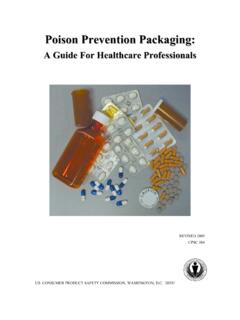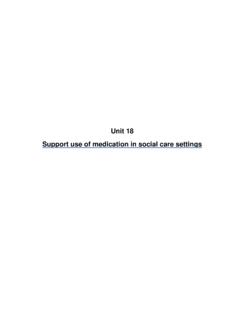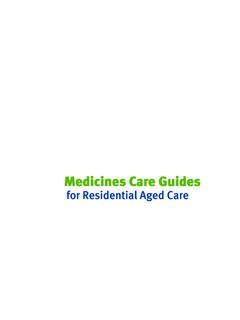Transcription of GUIDELINES ON PRACTICE IN HOSPITAL PHARMACY
1 The Manitoba Pharmaceutical Association 200 TACHE AVENUE, WINNIPEG, MANTIOBA R2H 1A7 TELEPHONE (204) 233-1411 FAX: (204) 237-3468 EMAIL: THE MANITOBA PHARMACEUTICAL ASSOCIATION HOSPITAL STANDARDS OF PRACTICE (For Community and Personal Care Home PRACTICE , Please refer to Personal Care Home & Community Standards of PRACTICE ) AND GUIDELINES ON PRACTICE IN HOSPITAL PHARMACY Standards of PRACTICE Last Revised July, 2002 GUIDELINES Approved by Council June 2004) 2 HOSPITAL STANDARDS OF PRACTICE TABLE OF CONTENTS 1. DRUG 3 All Areas .. 3 HOSPITAL PRACTICE .. 3 Responsibilities in the Refusal to Provide Products or Services for Moral or Religious Reasons .. 10 Responsibilities When Asked to Provide a Drug that May Harm the 10 2. PATIENT 11 3. DRUG INFORMATION 14 4. 16 5. HOURS OF PHARMACY 18 6. POLICIES AND PROCEDURES 19 7. LEGAL AND 21 8.
2 EXTEMPORANEOUS 22 9. MEDICATION 3 1. DRUG DISTRIBUTION Standard: EVERY PHARMACIST MANAGER SHALL BE RESPONSIBLE FOR THE PURCHASING, RECEIVING, STORAGE, DISTRIBUTION AND DISPOSAL OF DRUGS IN THE PHARMACY . Interpretation: A) All Areas of PRACTICE PHARMACY support personnel may be utilized to reduce the professional time committed to the mechanics of the drug distribution service without reducing the professional and legal control. B) Community PRACTICE (Please refer to Community Standards of PRACTICE ) C) HOSPITAL PRACTICE 1) Procurement of Drugs a) The purchase of all drugs shall be under the supervision of a pharmacist and in accordance with the Formulary Standard. b) The PHARMACY department shall establish and maintain adequate records of drug purchases necessary for inventory control and legal requirements. 2) Receiving/Storage of Drugs a) Narcotic and Controlled substances shall be delivered to the institution's PHARMACY department directly or, where applicable, to the receiving area and subsequently delivered to the PHARMACY department forthwith.
3 B) The pharmacist manager shall be responsible to ensure established policy and procedures provide for the proper storage of received drugs when storage within the PHARMACY department is not possible. c) The pharmacist manager shall be responsible to ensure established policy and procedures provide for the security of all medication received during the time elapsed from the actual receiving until it is stored properly by the PHARMACY . d) All drugs (including investigational drugs, patient's own medication from home and clinical evaluation packages ( samples) within the PHARMACY and throughout the HOSPITAL ) shall be stored under proper conditions of sanitation, temperature, light, humidity, ventilation, regulation and security. e) The PHARMACY personnel shall make regular inspections of all drugs storage areas. A written record shall verify that: 4 i) disinfectants and drugs for external use are stored separately from internal and injectable medications.
4 Ii) drugs requiring special environmental conditions for stability are properly stored. iii) no outdated drugs are stocked. iv) narcotics and controlled drugs substances are being stored with proper measures of security. v) drugs are not being overstocked. vi) drugs which may be required on an urgent or emergency basis are in adequate and proper supply. f) Patient medications no longer required are returned to PHARMACY . g) Standards of neatness and cleanliness are consistent with good medication handling practices. 3) Inventory Control The pharmacist shall maintain an inventory control system. 4) Drug Recall Procedure There shall be drug recall procedures that can be readily implemented. 5) Ordering The text of the medication orders shall include: a) the patient's name, age, HOSPITAL number and location b) the name of medication and dosage c) route and frequency of administration d) duration of treatment, if limited e) name of authorized prescriber f) date the order was written g) the time the order was written, if deemed appropriate h) for verbal orders, the name and signature of the person who received the order i) if pediatric patient, weight of child Provisions shall be made for sending the medication orders to the PHARMACY department and subsequently retaining the original medication order on the patient's chart.
5 Medication orders should be cancelled automatically when a patient goes to surgery and orders shall be rewritten postoperatively. All orders should be reviewed and rewritten by the physician when a patient changes service. 5 The use of standing orders shall be discouraged. The use of standing orders, if considered necessary, shall be approved individually by the appropriate HOSPITAL committee ( Medical Advisory Committee). They shall be reviewed annually and revised as necessary. They shall be available in a preprinted format so that a copy can be appended to the medical record and signed by the prescriber. The prescriber shall authorize their use and shall individualize each medication order according to the individual patient's needs. 6) Medication Profiles The PHARMACY department shall work toward developing a medication profile system for patients of the HOSPITAL . Medical profiles, once developed, should be reviewed before dispensing the patient's medication.
6 7) dispensing dispensing shall be restricted to the pharmacist or authorized personnel under the direction and supervision of the pharmacist. The pharmacist shall be responsible for the following: a) determining the authenticity and appropriateness of the medication order before dispensing . b) selecting auxiliary labels and/or cautionary statements. c) monitoring patient profiles, if available, for the detection of inappropriate drug therapy. d) final check on all aspects of the completed prescription. A stop-order procedure shall be developed for use when a definite number of doses or a time limitation for administration has not been stipulated by the physician on the drug order. Drug specific automatic stop-order policies shall be appropriate for the type of treatment given in the HOSPITAL . There shall be a system to notify the prescriber of the impending expiration of the medication order so that appropriate patient reassessment is completed prior to rewriting the order.
7 Pharmacists shall use standardized terminology, metric units, and generic nomenclature of all drug labels to minimize confusion. There shall be a list of abbreviations and symbols approved by the PHARMACY and Therapeutics Committee. Medication labels shall be typed or machine printed and shall be free from erasures and strikeovers. The labels shall be firmly affixed to the container. Medication containers shall not be altered by anyone other than PHARMACY personnel. i) Unit-Dose Medication System Unit-dose systems shall dispense medications contained in, and administered from, unit-dose packages. Not more than a twenty-four hour supply of unit dose medication shall be provided to the acute patient care area at any time. 6 The medication profile, if available, shall be utilized for the individual medication doses to be scheduled, prepared, distributed and administered on a timely basis. Unit-dose carts or medication trays shall be used as medication storage facilities on the ward.
8 The particular tray for a specific patient shall be labelled with the patient's name, location and HOSPITAL number. The following information shall be indicated on the individual dosage package: a) name of drug b) strength c) expiry date d) lot number ii) Individual Patient Prescription Medications shall be dispensed in individually labelled prescription containers. The amount of drug dispensed shall be determined by HOSPITAL policy. Medication for administration shall be labelled with the following information: a) name of the patient and location b) name and strength of the drug c) dose d) route of administration e) accessory or cautionary statements as required f) date dispensed g) name of HOSPITAL iii) Controlled Dosage System Medications shall be dispensed in individually-labelled controlled dosage cards/containers.
9 The system shall be designed so that each dose is designated for a specific time of administration. The amount of the drug dispensed shall be determined by HOSPITAL policy. Medication for administration shall be labelled with the following information: a) name of the patient and location b) name and strength of the drug c) dose d) route of administration e) accessory or cautionary statements as required f) date dispensed g) name of HOSPITAL The pharmacist shall exercise professional judgement at completion of the dispensing procedure to ensure the right drug is dispensed for administration to the right patient, in the right dose, via the right route, at the right time. 7 The processing of emergency "stat" orders shall be determined through written HOSPITAL policy.
10 8) Delivery Medication shall be delivered to the ward from the PHARMACY with the least amount of delay. All parts of the transportation system shall protect the medication from pilferage and breakage. Special procedures for delivery of Narcotic and Controlled medication shall be established to ensure that the drugs are delivered promptly, intact and placed in proper storage areas. 9) Returned Medications Owing to the inherent danger, drugs having different lot numbers and expiry dates should not be combined. Medications dispensed for administration, but not used, shall be returned to the PHARMACY . Procedures for returning drugs to stock shall be instituted. These shall include the following considerations: a) integrity of returned drug package b) proper storage of the drug on the nursing care station The following types of medication shall be discarded: a) any opened topical medications (including ophthalmic, otic and nasal medications) b) opened multi-dose and single dose vials c) any medication handled by the patient d) any medications returned by ambulatory patients e) improperly stored medications f) any open or used admixtures g) any opened liquid medications 10) Ward Stock Medications The PHARMACY shall establish a list of ward stock medications for each ward and that list shall be reviewed on an annual basis by the PHARMACY department.




